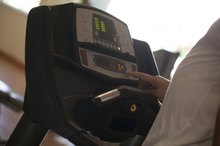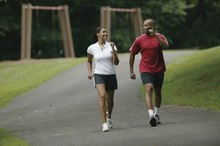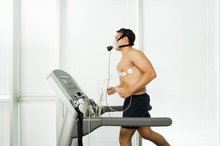What does fact checked mean?
At Healthfully, we strive to deliver objective content that is accurate and up-to-date. Our team periodically reviews articles in order to ensure content quality. The sources cited below consist of evidence from peer-reviewed journals, prominent medical organizations, academic associations, and government data.
The information contained on this site is for informational purposes only, and should not be used as a substitute for the advice of a professional health care provider. Please check with the appropriate physician regarding health questions and concerns. Although we strive to deliver accurate and up-to-date information, no guarantee to that effect is made.
How to Determine Walking Speed
You can use a number of methods to determine your walking speed using simple calculations. With a pedometer and a watch, you can quickly learn how fast you’re walking. Walking faster helps you burn more calories per minute by raising your heart rate 2. Lowering your speed lets you walk longer, helping you improve your cardiovascular stamina and muscular endurance so you can increase your calorie burn as you get in better shape.
Use an online service like MapMyWalk to plan your route. Click on your starting point -- whether that's your front door or a nearby park -- and your pre-determined end point; and the mileage will be calculated for you.
How to Convert Steps to Calories Burned
Learn More
Purchase a pedometer if you don't have a computer. It will measure the distance you walk based on the number of steps you take. Pedometers that take into account your height and stride length are the most accurate 1.
Calculate the number of steps you take in 1 mile as an alternate method of calculating your course distance. Measure how many steps you take walking 1 yard. A mile is 1,760 yards. If you take three steps per yard, you will take 5,280 steps per mile.
Steps to Miles Conversion for a Pedometer
Learn More
Walk the course, noting your start and finish times. Record your time after each mile and at the halfway point to create timed splits. Don’t rely on doubling the first-half results to provide accurate walking speeds for the entire walk. The first half of your course may be downhill, for example, and you’ll be more tired during the second half of your walk.
Take the number of minutes it took to walk 1 mile and calculate your speed. Divide 60 by the number of minutes it took you to walk 1 mile. If it took you 20 minutes to walk one mile, you walked at 3 mph, or 60 divided by 20. If you walk a mile in 15 minutes, divide 60 by 15 to get a walking speed of 4 mph. Alternately, divide the number of minutes you walked 1/2 mile by 30.
Tips
Choose a pace you feel you can maintain for 30 minutes or more without stopping. Harvard Health estimates that a 155 pound person will burn 298 calories walking for one hour at a speed of 3.5 mph and 372 calories per hour at 4.5 mph. Increase your calorie-burn by walking routes with hills and by jogging down them. This will change your per-hour walking time as you walk more slowly up steep hills and add several minutes of jogging downhill.
Related Articles
References
- Los Angeles Times: Pedometers Can Motivate Users to Get in Step
- Harvard Health Publications: Calories Burned in 30 Minutes for People of Three Different Weights
- Ainsworth BE, Haskell WL, Herrmann SD, et al. 2011 compendium of physical activities: a second update of codes and MET values. Med Sci Sports Exerc. 2011;43(8):1575-81. doi:10.1249/MSS.0b013e31821ece12
- Office of Disease Prevention and Health Promotion. Physical activity guidelines for Americans.
Writer Bio
Sam Ashe-Edmunds has been writing and lecturing for decades. He has worked in the corporate and nonprofit arenas as a C-Suite executive, serving on several nonprofit boards. He is an internationally traveled sport science writer and lecturer. He has been published in print publications such as Entrepreneur, Tennis, SI for Kids, Chicago Tribune, Sacramento Bee, and on websites such Smart-Healthy-Living.net, SmartyCents and Youthletic. Edmunds has a bachelor's degree in journalism.









